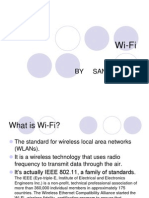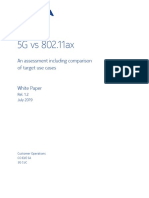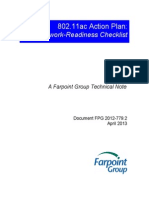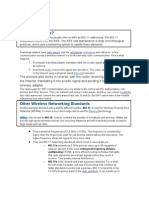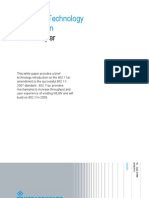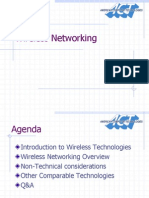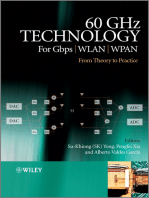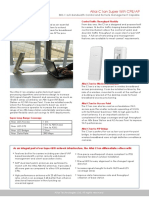802.11 Overview PDF
802.11 Overview PDF
Uploaded by
Sandeep PandeyCopyright:
Available Formats
802.11 Overview PDF
802.11 Overview PDF
Uploaded by
Sandeep PandeyOriginal Title
Copyright
Available Formats
Share this document
Did you find this document useful?
Is this content inappropriate?
Copyright:
Available Formats
802.11 Overview PDF
802.11 Overview PDF
Uploaded by
Sandeep PandeyCopyright:
Available Formats
Wireless Industry Standards Overview
Wireless Industry Standards &
WLAN Management:
What You Need to Know
2006, AirWave Wireless, Inc. All rights reserved.
Page 1 of 8
Wireless Industry Standards Overview
Standard
802.11a
Current Status
Ratified
Products now
available
Requirements
Requires new AP
hardware
Requires new AP
firmware
Requires client
device update
802.11b
Current Status
Ratified
Products now
available
Requirements
Requires new AP
hardware
Requires new AP
firmware
Requires client
device update
Summary
WLAN Management Implications
802.11a uses the less-crowded 5GHz spectrum rather
than the 2.4GHz spectrum used by 802.11b and
802.11g. 802.11a delivers faster throughput, with
theoretical maximum data rates of 54 Mbit/second and
real world data rates of 20+ Mbit/second. Because
there are more channels available in the 5GHz
spectrum, 802.11a wireless LANs typically experience
less interference from overlapping channel assignments
and other devices.
However, signals at 5GHz dont always travel through
some materials as well as 2.4GHz signals, so the overall
coverage footprint of an 802.11a radio may be smaller
than a comparable 802.11b/g device.
WLAN management solutions must support dual
radio wireless access points and make it easy
for the Help Desk to determine which radio each
user is connected to.
Visualization and planning tools must display
and monitor information on coverage in both the
2.4GHz and 5 GHz spectrum.
Management tools must understand the 5 GHz
frequency restrictions in Europe
Management tools must be able to configure
11a spectrum for specific use per radio
configuration capabilities like voice only.
Unfortunately, 802.11a is not backward compatible with
802.11b/g so a user with an 802.11b-enabled laptop
cannot connect to an 802.11a wireless access point.
Since the majority of Wi-Fi-enabled devices today use
802.11b/g, few organizations have networks that are
purely 802.11a. Instead, most organizations using
802.11a today utilize dual radio wireless access points
with both an 802.11a radio and an 802.11b/g radio or trimode radios (802.11a/b/g) to ensure that all devices can
connect to the Wi-Fi network.
The first shipping update to the protocol for Wi-Fi
products, operating in the 2.4 GHz spectrum, 802.11b
increased the maximum speed from 2 Mbit/second to 11
Mbit/second. 802.11b radios typically provide an indoor
coverage radius of 90-175 feet, depending on the
environment. Virtually all wireless devices today support
802.11b.
Channel assignments and RF transmission power
need to be adjusted to avoid interference as
wireless network utilization grows.
Most organizations use only three of the 14 available
channels (channels 1, 6, and 11 in the US regulatory
domain), because channels must be spaced at least 5
apart to minimize overlap (to reduce RF interference)..
With only three channels available, it is particularly
important to optimize channel assignments to avoid
interference when multiple access points are installed in
close proximity to one another. In addition, many other
non-Wi-Fi devices use the 2.4 GHz spectrum, which can
create additional interference.
Where multiple hardware vendors products are in
use, multi-vendor management is essential to
ensure optimization across all platforms sharing
the airspace.
2006, AirWave Wireless, Inc. All rights reserved.
Page 2 of 8
Management solutions must provide automated
optimization algorithms to control RF settings to
eliminate repetitive manual configuration changes.
Management systems must monitor user signal
quality and network performance to help IT
diagnose RF interference when it occurs.
Management systems must be able to support
802.11 legacy clients that only support (long
preamble).
Wireless Industry Standards Overview
Standard
802.11g
Current Status
Ratified
Products now
available
Requirements
Requires new AP
hardware
Requires new AP
firmware
Requires client
device update
802.11e:
Quality of
Service
(WMM)
Current Status
Ratified
Products now
available
Requirements
Requires new AP
hardware
Requires new AP
firmware
Requires client
device update
Summary
WLAN Management Implications
802.11g was a protocol update using the same 2.4Ghz
spectrum as 802.11b adding support for higher speeds
(up to a maximum of 54Mbits/second) like 802.11a.
Unlike 802.11a, 802.11g is backward-compatible with
802.11b devices. This has made it an extremely popular
choice for enterprises, most of which still have a
significant number of clients with single-mode 802.11benabled client devices. However, the presence of any
802.11b devices (whether they are a part of your
network or not) will reduce the throughput of the
802.11g network.
802.11g uses the same spectrum as 802.11b, so it
is susceptible to the same issues surrounding RF
interference (see discussion above).
802.11e is a newly-ratified standard that allows network
administrators to differentiate and prioritize classes of
traffic. This will allow the Wi-Fi network infrastructure to
deliver acceptable performance for a broader range of
applications and to support a larger number of
simultaneous users.
Each of the WMM traffic buckets (voice, video,
best effort, background) will need to be monitored
individually to ensure quality of service enabling
you to see how much traffic is flowing in each
category and how much headroom you have on
your network.
Typically, organizations will use 802.11e to give priority
to voice and video traffic, since those applications are
highly delay-sensitive and can quickly become unusable
if data transmission is interrupted. When voice and data
traffic are given priority, ordinary data traffic will typically
be given a lower best effort priority.
Your management solution will need to display the
type of traffic client is generating, along with other
appropriate metrics for each class.
802.11e is thus most immediately important to
organizations that will be using wireless Voice Over IP
applications.
WMM is a subset of 802.11e.
Today, most customers with wireless voice use
multiple VLANs/SSIDs with proprietary voice
prioritization schemes. Your management solution
will need to allow you to test an 802.11e or WMM
scheme on a segment of your network and then
migrate efficiently to the rest of the WLAN when
successful.
Management systems will need to incorporate
network latency metrics along with 802.11e
support to provide end-to-end voice quality
metrics.
Management systems must provide detailed
historical trend reports to enable you to track
network usage for capacity planning.
Management systems must provide automated,
efficient RF spectrum management to ensure that
signal quality is adequate for voice and video
applications.
2006, AirWave Wireless, Inc. All rights reserved.
Page 3 of 8
Wireless Industry Standards Overview
Standard
802.11i:
Security
Plus:
WPA (WiFi Alliance)
WPA2 (WiFi Alliance)
Current Status
Ratified
Products now
available
Requirements
Requires new AP
hardware
Requires new
AP firmware
Requires client
device update
Summary
WLAN Management Implications
There have been several security standards and most
are still in active use in many enterprises.
WEP (Wired Equivalent Privacy)
The original Wi-Fi security standard for authenticating
and encrypting traffic between client devices and access
points. WEP, relies on a single shared key for all users.
WEP has been shown to have numerous design and
implementation flaws and is not very difficult to crack.
However, for some organizations with numerous legacy
client devices, WPA and WPA2 may not be supportable
and WEP is still used.
WPA
A Wi-Fi industry standard that repaired WEP through
improved use of the RC4 cipher (TKIP), message
integrity checks, and more effective key management
(via RADIUS/802.1x). WPA requires that both client
devices and wireless infrastructure be WPA-compliant.
The need to ensure client compatibility has slowed WPA
roll-outs, and many organizations implement WPA only
on certain VLANs that are used by compliant client
devices.
802.11i (WPA2)
New standard for enhanced security that replaces prior
encryption algorithms with the stronger AES (Advanced
Encryption Standard). WPA2 typically requires updated
WLAN hardware and client devices, which has slowed
adoption rates.
Because of the rapid evolution of technology and the
challenges of implementing new standards across all
client devices and infrastructure, many large enterprises
have multiple security policies in place simultaneously.
2006, AirWave Wireless, Inc. All rights reserved.
Page 4 of 8
Your management solution should support groupbased management to allow you to implement new
security policies on segments of your network, as
appropriate.
Management solutions must support multiple
VLANs and SSIDs for organizations that will
operate multiple security policies simultaneously.
Management solutions should provide full
inventory reports listing all access points and
infrastructure devices, indicating which product
and firmware versions are in place. With this
information, you can verify which devices are
capable of supporting the new security schemes.
Migrating to WPA/WPA2 requires massive
firmware (or hardware) updates in most
organizations. Management solutions must
automate firmware management and distribution.
If WEP continues to be used:
Your management solution should be able to
rotate keys frequently, across your entire network.
Your management solution should be able to
generate random keys for additional security.
Wireless Industry Standards Overview
Standard
802.11k:
Radio Resource
Management
Current Status
Ratified
Products now
available
Requirements
Requires new
AP hardware
Requires new AP
firmware
Requires client
device update
Summary
WLAN Management Implications
802.11k provides a standard statistical measurement
framework to properly monitor wireless LANs. This
framework provides a mechanism for communication
between wireless access points and clients which
enables RF and other data to be gathered from client
devices to evaluate the quality of their connection and
make better roaming and spectrum management
decisions.
While the 802.11k standard has not yet been fully
ratified, some devices currently support a pre-standard
subset of the features in the proposed standard.
NOTE: 802.11k provides a mechanism for monitoring
wireless client devices, not for configuration of clients.
802.11v builds on 802.11k to make it possible to
configure clients and APs based on this information.
Management solutions need to be designed to
request and gather the newly available client
information without overloading the network with
management traffic.
Management solutions will need to be able to
incorporate data from the new Peer Statistics
Table to gain true insight into the RF environment
in which the client is located.
Network management solutions should utilize the
new interference measurements in order to
dynamically tune the network infrastructure to
deliver optimal performance (i.e., detecting new
sources of interference and changing RF settings
to mitigate their impact). The volume of RF data
that will be available dictates that this analysis
must be automated.
New location services will enable more accurate
client and RFID tracking using RF data from client
devices and access points. Management solutions
must provide visualization tools that leverage and
present this data.
Management solutions should be able to utilize
new neighbor reports and channel load reports to
assist in load balancing and WLAN optimization.
802.11k will require firmware and/or hardware
upgrades. Effective management solutions will
provide appropriate inventory reports and will
automate the firmware upgrade process.
802.11n
Current Status
Ratified
Products now
available
Requirements
Requires new AP
hardware
Requires new AP
firmware
Requires client
device update
The 802.11n standard provides enhancements for
higher throughput (100-600+ Mbits/second). 802.11n
will be based on MIMO/OFDM and will be backwardscompatible to support 802.11a and 802.11g client
devices. 802.11n will be particularly useful where
bandwidth-intensive services, like video, must be
delivered.
Management solutions must be designed with the
flexibility to support 802.11n (when ratified) in
addition to previously ratified standards.
Caution: The 802.11n standard has not yet been ratified
and pre-n products may not be upgradeable.
Management solutions must know which devices
support the new standard for planning purposes.
2006, AirWave Wireless, Inc. All rights reserved.
Page 5 of 8
With bandwidth-intensive services like video,
throughput must be monitored closely to ensure
acceptable performance. Management solutions
must provide both real-time and historical trending
data.
Wireless Industry Standards Overview
Standard
802.11p:
WAVE
Current Status
Ratified
Products now
available
Requirements
Requires new AP
hardware
Requires new AP
firmware
Requires client
device update
802.11r:
Fast Roaming/
Fast Handoff
Current Status
Ratified
Products now
available
Requirements
Requires new AP
hardware
Requires new AP
firmware
Requires client
device update
Summary
WLAN Management Implications
802.11p is designed to enable operation of wireless
LAN stations in motor vehicles in a highway
environment. The communications provided by
Wireless Access in Vehicular Environments (WAVE)
will generally occur over distances up to 1,000 m
(between roadside stations or between high-speed
vehicles) and at highly variable speeds. Additional
performance requirements are needed to address the
motion-related effects (see 20.3.10.6).
Management solutions should eventually be able
to track and locate clients traveling at a high rate of
speed.
802.11r is defined to minimize the transition time when
roaming between wireless access points to maintain
seamless connectivity for the user. Client devices are
pre-authenticated to neighboring access points to
which they might roam in order to minimize transition
time. Pre-authentication may be accomplished over the
air or across the wired network via 802.11rs neighbor
report.
Management solution must help IT understand
which devices (both client devices and wireless
access points) on their networks are capable of
supporting this standard.
This is especially important for wireless VOIP and other
applications where latency is critical to performance.
802.11r is designed to allow clients to maintain their
security and QoS connection status on the new access
point. The overall changes to the protocol will not
introduce any new security vulnerabilities beyond the
current 802.11 standard and its amendments. It
preserves the behavior of legacy infrastructure and
devices.
2006, AirWave Wireless, Inc. All rights reserved.
Page 6 of 8
Management solutions will need to be able to
visualize outdoor RF environments.
Management solution will need to configure the
wireless access points to support fast roaming,
integrating the authentication servers.
Management solutions will need to monitor the
entire authentication process to ensure fast
roaming, gathering data from APs, clients, and
authentication servers. When failures occur, the
management system must help the IT staff
analyze where the failure occurred.
Wireless management solutions must be able to
create a list of neighboring access points in order
to configure and populate proper roaming targets
per cell.
Wireless Industry Standards Overview
Standard
802.11s:
Mesh
Networking
Current Status
Ratified
Products now
available
Summary
WLAN Management Implications
The 802.11s standard is designed to enable selforganizing infrastructure network meshes, primarily for
outdoor networks. This has the potential to reduce
backhaul requirements and installation costs,
accelerating the adoption of large municipal networks.
The extent to which 802.11s is adopted will depend on
the willingness of the hardware vendors to shift from
proprietary protocols.
Management solutions will need to monitor the
QoS of the network backhaul
The 802.11u standard is intended to address handoff
between 802.11 networks and non-802.11 networks
(i.e., cellular).
Network management systems will need to
understand the roaming from network to network
as well as from AP to AP.
Management solutions will need to graphically
render large outdoor RF environments and
dynamic meshes
Remote provisioning and configuration of outdoor
devices will be critical for cost-effective operation
of mesh networks.
Requirements
Requires new AP
hardware
Requires new AP
firmware
Requires client
device update
802.11u:
Wireless
Interworking
with External
Networks
Current Status
Ratified
Products now
available
The ratification of this standard is expected to
dramatically accelerate the adoption and deployment of
wireless voice applications because it will let mobile
workers carry a single phone.
Requires new AP
hardware
Requires new
AP firmware
Requires client
device update
2006, AirWave Wireless, Inc. All rights reserved.
Management solution must be able to dynamically
adapt to clients on the network according to what
types of services they are demanding.
Management solution should be able to provide
QoS reports for the various network operations
leveraging the access point.
Requirements
Management solutions will need to track and
display what types of clients are roaming onto the
WLAN and what types of services they are
consuming (voice, data, and video).
Page 7 of 8
Wireless Industry Standards Overview
Standard
802.11v:
Current Status
Ratified
Products now
available
Requirements
Requires new AP
hardware
Requires new AP
firmware
Requires client
device update
Summary
WLAN Management Implications
The 802.11v standard would enable centralized
management (monitoring and configuring) of wireless
client devices (stations) through a Layer 2 mechanism.
While 802.11k is designed to retrieve information from
client devices, it does not provide the ability to configure
the device itself. 802.11v would create an Access Point
Management Information Base (AP MIB) to be used for
remote configuration of client devices for:
RF Management
Wireless management systems would be able to
centrally configure client device security settings to
comply with policies.
Management solutions would be able to manage
firmware distribution to client devices as well as to
the Wi-Fi infrastructure.
Management solutions would be able to perform
event correlation and diagnostics on client-related
issues and automatically implement corrective
actions by changing network and/or client settings.
Management solution should be able to configure
clients and wireless access points for more
effective power-saving to enhance the
performance of small form factor 802.11 devices
(like phones and palm tops).
Dynamic channel selection
Access Point Coordination
Spectrum Coexistence
Load Balancing
Network Controlled handoffs with client
participate
Location based management
With configuration control over client devices,
management solutions will be able to prevent
clients from associating to unauthorized rogue
access points.
Updating FW on clients
Client diagnostics
MIB Interface to enable centralized control
Rogue/Fake APs/SSIDs
802.11w:
Protected
Management
Frames
Current Status
Ratified
Products now
available
802.11w is intended to provide mechanisms to protect
802.11 management frames (including action
management frames, deauthentication and
disassociation frames). It is needed in order to address
security gaps (especially in disassociation and
deauthentication) and could help prevent some (but not
all) denial of service attacks.
Requirements
Requires new AP
hardware
Requires new AP
firmware
Requires client
device update
2006, AirWave Wireless, Inc. All rights reserved.
Page 8 of 8
Management solution must help IT understand
which devices support this standard (clients and
APs) and implement the appropriate settings on
those that do.
You might also like
- The 802.11 Family ExplainedDocument2 pagesThe 802.11 Family ExplainedWella Binay BuenaobraNo ratings yet
- 802.11 Wireless Network Site Surveying and InstallationDocument115 pages802.11 Wireless Network Site Surveying and Installationj.emmett.dwyer1033No ratings yet
- Performance of Switched-Capacitor Circuits Due To Finite Gain AmplifiersDocument21 pagesPerformance of Switched-Capacitor Circuits Due To Finite Gain AmplifiersSandeep PandeyNo ratings yet
- Fortinet Wireless Product MatrixDocument14 pagesFortinet Wireless Product MatrixFelipe Gabriel Nieto ConchaNo ratings yet
- 100 Top WiFi Multiple Choice Questions and Answers - Connect My GuruDocument9 pages100 Top WiFi Multiple Choice Questions and Answers - Connect My GuruRonnel SingsonNo ratings yet
- User Manual: Product Name: Smart Phone Model Name: BV9800 Brand Name: BlackviewDocument14 pagesUser Manual: Product Name: Smart Phone Model Name: BV9800 Brand Name: BlackviewStefano SavianNo ratings yet
- Offensive Security WirelessDocument193 pagesOffensive Security Wireless0day adminNo ratings yet
- 802.11 StandardDocument3 pages802.11 StandardDaljit SinghNo ratings yet
- InfoWorld Red File Report Wireless LANsDocument15 pagesInfoWorld Red File Report Wireless LANsJOSE JUAN ZUÑIGANo ratings yet
- 802.11ac: The Fifth Generation of Wi-Fi: Technical White PaperDocument25 pages802.11ac: The Fifth Generation of Wi-Fi: Technical White PaperSubash ShresthaNo ratings yet
- Motoroal - 802.11ac White PaperDocument10 pagesMotoroal - 802.11ac White PaperL1architectNo ratings yet
- Wi-Fi Best PracticesDocument7 pagesWi-Fi Best Practiceshotsync101No ratings yet
- Wireless Networks - 802.11Document43 pagesWireless Networks - 802.11Pranali ChavanNo ratings yet
- Wireless Networks - 802.11Document43 pagesWireless Networks - 802.11Pranali ChavanNo ratings yet
- White Paper: 802.11ac Survey: Gigabit Wifi Has ArrivedDocument9 pagesWhite Paper: 802.11ac Survey: Gigabit Wifi Has ArrivedAndyNo ratings yet
- 802.11ac Overview: Why Is 802.11ac Needed?Document4 pages802.11ac Overview: Why Is 802.11ac Needed?javierdb2012No ratings yet
- Things You Should Know About Enterprise WLANDocument5 pagesThings You Should Know About Enterprise WLAN779482688100% (1)
- Understanding Technology Options For Deploying Wi-Fi White PaperDocument43 pagesUnderstanding Technology Options For Deploying Wi-Fi White Paperophyx007No ratings yet
- Mobile Computing Assignment: Submitted by Sakaanaa M 2017115583Document31 pagesMobile Computing Assignment: Submitted by Sakaanaa M 2017115583Sakaanaa MohanNo ratings yet
- WiFi Standards 802.11a B G N vs. 802.11acDocument3 pagesWiFi Standards 802.11a B G N vs. 802.11acDavid SofitaNo ratings yet
- Wireless StandardsDocument17 pagesWireless Standardsvenkatesh kulkarniNo ratings yet
- 802.11n: Next-Generation Wireless LAN Technology: White PaperDocument13 pages802.11n: Next-Generation Wireless LAN Technology: White PapermanjunathbhattNo ratings yet
- 802.11n: Next-Generation Wireless LAN Technology: White PaperDocument13 pages802.11n: Next-Generation Wireless LAN Technology: White PaperALEXANDRE JOSE FIGUEIREDO LOUREIRONo ratings yet
- Wi FiDocument27 pagesWi FiHarish KumarNo ratings yet
- 802.11n Wireless Technology Overview: Deploying The Next Generation of High Performance WirelessDocument7 pages802.11n Wireless Technology Overview: Deploying The Next Generation of High Performance WirelessswalayNo ratings yet
- Cisco's Unified Wireless Solutions: Aduait Pokhriyal ID - No. 34915Document34 pagesCisco's Unified Wireless Solutions: Aduait Pokhriyal ID - No. 34915Aduait PokhriyalNo ratings yet
- 802.11 WlanDocument27 pages802.11 WlanAparnaSkpNo ratings yet
- CS8601-Mobile Computing (Wireless Networking Standards Notes) ياسرDocument4 pagesCS8601-Mobile Computing (Wireless Networking Standards Notes) ياسرYasar BilalNo ratings yet
- WifiDocument7 pagesWifiLucky Dwaine ValbuenaNo ratings yet
- Wireless NetworksDocument8 pagesWireless NetworksazzanNo ratings yet
- ch#4Document26 pagesch#4Getaneh AwokeNo ratings yet
- Huawei Wi-Fi 6 METODOLOGIA (IEEE 802.11ax) Technology White PaperDocument29 pagesHuawei Wi-Fi 6 METODOLOGIA (IEEE 802.11ax) Technology White PaperLeidy ChNo ratings yet
- CHAPTER 6 LastDocument51 pagesCHAPTER 6 Lasttemesgenbekele371No ratings yet
- Wireless AssignmentDocument9 pagesWireless AssignmentHamna BaigNo ratings yet
- 802.11 - Wi-Fi Standards and Speeds Explained - Network World PDFDocument6 pages802.11 - Wi-Fi Standards and Speeds Explained - Network World PDFTecnologia MasterNo ratings yet
- Term Paper Synopsis - 1Document6 pagesTerm Paper Synopsis - 1psdNo ratings yet
- 5G Vs WiFi 6Document14 pages5G Vs WiFi 6Bala JE/BSNLNo ratings yet
- Mobile Ad-Hoc Networks: Presentation OnDocument16 pagesMobile Ad-Hoc Networks: Presentation Onapi-26830587No ratings yet
- Hamza Wi-Fi Term PaperDocument11 pagesHamza Wi-Fi Term Paperhamzabilal90No ratings yet
- Ap 7532 Data SheetDocument7 pagesAp 7532 Data SheetStephenNo ratings yet
- Understanding and Optimizing 802.11Document8 pagesUnderstanding and Optimizing 802.11brancilosNo ratings yet
- Aerohive Datasheet AP130Document2 pagesAerohive Datasheet AP130Edson GriaNo ratings yet
- Wifi SeminarDocument10 pagesWifi SeminarAmandeep AmanNo ratings yet
- 802.11ac Action Plan:: A Network-Readiness ChecklistDocument9 pages802.11ac Action Plan:: A Network-Readiness Checklista_sahaiNo ratings yet
- Wireless Lans: Chapter FourDocument11 pagesWireless Lans: Chapter FourMehari Temesgen0% (1)
- UntitleddocumentDocument5 pagesUntitleddocumentArpit TiwariNo ratings yet
- Mobile ComputingDocument16 pagesMobile ComputingAbir ChowdhuryNo ratings yet
- Wifi PDFDocument2 pagesWifi PDFthe_szabikaNo ratings yet
- Wifi PDFDocument2 pagesWifi PDFthe_szabikaNo ratings yet
- Lecture 3 - Wireless NetworksDocument52 pagesLecture 3 - Wireless NetworksTanveer Ahmed HakroNo ratings yet
- Pheenet Wap 654g and Wap 654gp User Manual Ver1.1Document59 pagesPheenet Wap 654g and Wap 654gp User Manual Ver1.1onehotminuteNo ratings yet
- IEEE 802.11g: The New Mainstream Wireless LAN StandardDocument12 pagesIEEE 802.11g: The New Mainstream Wireless LAN StandarddeviNo ratings yet
- 802 11acDocument29 pages802 11acHarshaNo ratings yet
- Wi-Fi CERTIFIED™ 802.11n Draft 2.0: Longer-Range, Faster-Throughput, Multimedia-Grade Wi-Fi® NetworksDocument18 pagesWi-Fi CERTIFIED™ 802.11n Draft 2.0: Longer-Range, Faster-Throughput, Multimedia-Grade Wi-Fi® NetworksRijil R SugathanNo ratings yet
- Wireless NetworkingDocument5 pagesWireless NetworkingPrateek_Gemini_4947No ratings yet
- WP Netgear 802 11ac WifiDocument5 pagesWP Netgear 802 11ac WifivladotrkuljaNo ratings yet
- Wireless NetworksDocument14 pagesWireless NetworksNagendra Kumar100% (1)
- Wireless 5Document30 pagesWireless 5ebinVettuchirayilNo ratings yet
- CWNA Certified Wireless Network Administrator Study Guide: Exam CWNA-108From EverandCWNA Certified Wireless Network Administrator Study Guide: Exam CWNA-108No ratings yet
- Reconfigurable Radio Systems: Network Architectures and StandardsFrom EverandReconfigurable Radio Systems: Network Architectures and StandardsNo ratings yet
- 60GHz Technology for Gbps WLAN and WPAN: From Theory to PracticeFrom Everand60GHz Technology for Gbps WLAN and WPAN: From Theory to PracticeNo ratings yet
- Solar Water HeaterDocument2 pagesSolar Water HeaterSandeep PandeyNo ratings yet
- The MOSFET Current MirrorDocument5 pagesThe MOSFET Current MirrorSandeep Pandey100% (2)
- Ethernet Based Security SystemDocument18 pagesEthernet Based Security SystemSandeep Pandey100% (1)
- Boundary Scan TutorialDocument58 pagesBoundary Scan TutorialSandeep Pandey100% (1)
- MOSFET Biasing Using A Current MirrorDocument5 pagesMOSFET Biasing Using A Current MirrorSandeep Pandey100% (1)
- CS 4441 - Networks II: Wi-FiDocument22 pagesCS 4441 - Networks II: Wi-FiGemma Ubuhle TsotetsiNo ratings yet
- Chapter 7: Basic Wireless Concepts and Configuration: CCNA Exploration 4.0 CCNA Exploration 4.0Document75 pagesChapter 7: Basic Wireless Concepts and Configuration: CCNA Exploration 4.0 CCNA Exploration 4.0Antoni PribadiNo ratings yet
- Wireless Networks NotesDocument20 pagesWireless Networks Noteskundan100% (3)
- Lecture 3 - Wireless NetworksDocument52 pagesLecture 3 - Wireless NetworksTanveer Ahmed HakroNo ratings yet
- RG-RAP Series Access Points Release Notes, ReyeeOS 2.262Document19 pagesRG-RAP Series Access Points Release Notes, ReyeeOS 2.262nuhamafaza08No ratings yet
- Lanly-G14ADocument3 pagesLanly-G14AFRANCISCO BATISTANo ratings yet
- Wireless Communications: Homework 3Document4 pagesWireless Communications: Homework 3Fatemeh NikraftarNo ratings yet
- Emerging Wireless Standards - Wifi, Zigbee and Wimax: Bhavneet Sidhu, Hardeep Singh, and Amit ChhabraDocument6 pagesEmerging Wireless Standards - Wifi, Zigbee and Wimax: Bhavneet Sidhu, Hardeep Singh, and Amit ChhabraPrem KumarNo ratings yet
- Wifi Interview QuestionsDocument7 pagesWifi Interview QuestionsronyiutNo ratings yet
- Ics 2306: Computer Networks: Wireless DevicesDocument75 pagesIcs 2306: Computer Networks: Wireless DevicesPeter KamauNo ratings yet
- ZoneFlex R700 Specifications PDFDocument9 pagesZoneFlex R700 Specifications PDFgetivaNo ratings yet
- PW0 100 FDocument192 pagesPW0 100 Fmasudrana7300No ratings yet
- Elitebook 840 g5 TouchscreenDocument41 pagesElitebook 840 g5 TouchscreenAlexy NdeffoNo ratings yet
- Wireless: 60Ghz Technologies and TestingDocument2 pagesWireless: 60Ghz Technologies and TestingSubba Rao TNo ratings yet
- Wireless Local Area NetworkDocument39 pagesWireless Local Area Networkmuvin236No ratings yet
- WiFi QnsDocument5 pagesWiFi QnsJayakrishnan MarangattNo ratings yet
- Vehicular Communications: Pranav Kumar Singh, Sunit Kumar Nandi, Sukumar NandiDocument39 pagesVehicular Communications: Pranav Kumar Singh, Sunit Kumar Nandi, Sukumar NandiHiba AyoubNo ratings yet
- Week 8Document125 pagesWeek 8Ahsen KamalNo ratings yet
- Quickspecs: HP 255 G7 Notebook PCDocument21 pagesQuickspecs: HP 255 G7 Notebook PCEron TRNo ratings yet
- Training Sequence Assisted Channel Estimation For Mimo Ofdm: Sumei Sun, Ingo Wiemer, C. K. Ho, and T. T. TjhungDocument6 pagesTraining Sequence Assisted Channel Estimation For Mimo Ofdm: Sumei Sun, Ingo Wiemer, C. K. Ho, and T. T. TjhungSandeep SunkariNo ratings yet
- Wifi Phy TestDocument44 pagesWifi Phy TestNgo Tan BinhNo ratings yet
- CnPilot Cert 1 7 Introduction All C7Document369 pagesCnPilot Cert 1 7 Introduction All C7Tiago MunizNo ratings yet
- SXT Sixpack: Five SXT Units and One Omnitik As A KitDocument2 pagesSXT Sixpack: Five SXT Units and One Omnitik As A Kitsantiago7289No ratings yet
- Implementation of Wireless Communications Systems On FPGA-Based PlatformsDocument11 pagesImplementation of Wireless Communications Systems On FPGA-Based Platformssigha josueNo ratings yet
- OFDMA and MIMO Notes: EE 442 - Spring SemesterDocument53 pagesOFDMA and MIMO Notes: EE 442 - Spring Semesterparvej khanNo ratings yet
- Altai C1An Super Wifi Cpe/Ap Control Traffic Throughput FlexiblyDocument2 pagesAltai C1An Super Wifi Cpe/Ap Control Traffic Throughput FlexiblyRoyer Casaverde DiazNo ratings yet
- DCF Throughput Analysis of IEEE 802.11a:g:n-Based Mobile LAN Over Correlated Fading ChannelDocument16 pagesDCF Throughput Analysis of IEEE 802.11a:g:n-Based Mobile LAN Over Correlated Fading ChannelLia AstuteNo ratings yet























